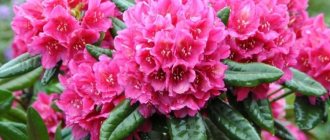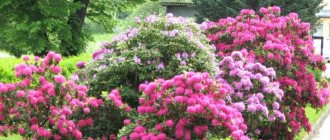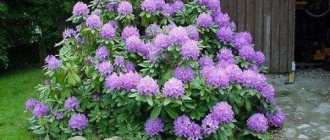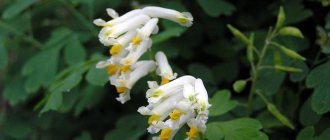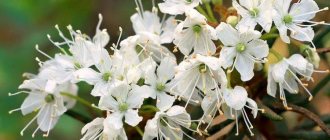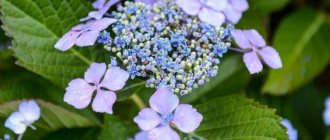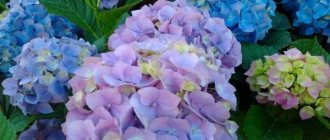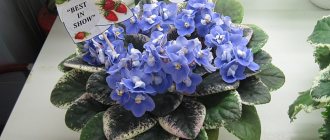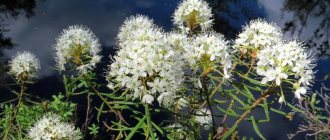It is difficult to imagine modern landscape design without rhododendron. Every self-respecting gardener wants to see not once, but several times these beautiful flowering shrubs in his collection. Fortunately, a great many varieties have already been bred. But there are not so many winter-hardy ones that would be suitable for our harsh winters. One of these will be discussed today.
Rhododendron hague, a hybrid of Finnish selection, was bred in 1974 as part of a rhododendron breeding program. Finnish hybrids are famous for their tolerance to low temperatures. Rhododendron hague is not just a beautiful evergreen shrub, but also especially winter-hardy. It easily tolerates sub-zero temperatures in winter, and in summer it delights with lush flowering.
History of origin
Rhododendron Haaga, according to historical information, was bred in Finland in 1974 at the University of Helsinki. This is the fruit of selection based on the Katevbinsky variety of rhododendrons. To date, more than 80 varieties of this type of rhododendron are known.
Rhododendron Hague - an evergreen shrub with lush flowers
For your information! On the Internet you can find another name - rhododendron Gaga, but this is just a mistake in spelling the variety. Only the Hague rhododendron appears in the botanical encyclopedia.
This species has a spherical crown of regular shape, quite branched and dense. The shrub is evergreen, perennial, reaching 1.5-2 m in height and up to 1.5 m in width. Unlike the more famous wild rosemary in Russia, wild rosemary has much denser inflorescences - up to 20 flowers per branch. The branches are gray, smooth, the flowers are large, rich pink in color with a scattering of red spots on the inside, wavy along the edges.
The leaves are dark green, up to 8 cm long and up to 5 cm wide. The petiole reaches a length of up to half the size of the leaf. The hybrid rhododendron Haaga blooms for a short time, only 2-3 weeks, starting in mid-June. Can grow both in partial shade and in the sunny side.
Distinctive features include a significant foliage part (unlike other varieties), large and lush inflorescences during the flowering period. Plus it is evergreen.
Important! The evergreen shrub changes its foliage every two years, and in winter it rolls its leaves into a tube, reducing moisture evaporation.
Landing Features
In the garden, the University of Helsinki rhododendron will help decorate paths or an alpine slide. It will create an excellent composition with any ornamental plants. It is especially good in combination with thuja or juniper. Its dark green foliage will provide an expressive backdrop for flowering varieties. But for this you need to land in compliance with all the rules.
Site selection and preparation
This variety of rhododendron should be planted only in shaded areas. However, too thick shade will not contribute to a lush crown and abundant flowering. It can be placed in the shade of a building on the north side or near a fence, which can protect not only from intense light, but also from strong winds. A shady shelter with the crown of coniferous or deciduous trees is also suitable. When choosing the right company, you need to remember that the roots of rhododendron are located close to the surface.
Important! Prolonged exposure to direct sunlight poses a danger to the plant.
- Ideal fit:
- oak;
- spruce;
- larch;
- fruit trees.
These plants have deep roots, so they will not reduce the living space of the bush and will not affect the supply of nutrients.
- It is undesirable to be located next to:
- linden;
- chestnut;
- maple;
- alder;
- poplar;
- elm;
- willow
Near these trees, rhododendron will require increased additional nutrition.
Also check out the Tarragona rhododendron variety.
For successful growth and development, the soil must meet a number of requirements:
- It should be loose enough to allow the roots to receive the required amount of air.
- Optimal is a large amount of nutritious humus and the absence of lime in the composition.
- Requires an acidic environment.
- There must be at least a meter to groundwater, because in a wetland the plant will die.
The shrub reacts positively to nearby bodies of water (natural or artificial). If they are not there, once a week or more often before the flowering period, the plantings will need to be sprayed to increase air humidity. The distance between two rhododendrons should be at least 1.5–2 m so that there is enough space for the growing root system.
Preparation of seedlings
It is best to buy seedlings from professional nurseries. It is advisable that their age be 2–4 years.
External signs to pay attention to:
- The bush should branch densely.
- Young shoots of well-developed specimens are located at the very root collar.
- Healthy foliage has an even, rich color - without spots or bumps on the surface. The presence of any defects may indicate a disease or the consequences of an “attack” of pests.
- The color of the roots should be uniform, without inclusions or wet areas.
Before planting, it is necessary to partially or completely remove the buds from the seedlings, since they take a lot of energy from the plant, preventing faster rooting.
Landing rules
Rhododendron seedlings are planted at the University of Helsinki in late April or early May. An autumn planting option is also possible.
When preparing the site before planting, you must stock up in advance on a mixture of:
- leaf soil (3 parts);
- pine needles (1 tsp);
- peat (2 hours).
A prerequisite is the application of mineral fertilizer - approximately 70 g per hole.
The main stages of planting work:
- Prepare a medium-sized planting hole: the diameter is about 0.6 m and the depth is 0.4-0.5 m. More precise “dimensions” depend on the root system of the seedling.
- It is imperative to lay a drainage layer up to 0.2 m thick. This can be sand or brick chips.
- The hole needs to be filled with the prepared substrate and lightly compacted. Make a hole.
- Pre-soak the seedlings with their roots in water.
- Place the bush in the hole, being careful not to damage the roots and not deepening them too much.
- Fill the space with soil mixture and form a tree trunk circle with the sides.
- The planting needs to be watered abundantly.
Video: choosing a location and planting rhododendron
The soil should be moistened to about 0.2 m. The height of the bush is important in calculating the required amount of water. For a plant no higher than 0.5 m, 5 liters will be enough. If the height exceeds half a meter, then the quantity must be increased to 10 liters.
Use in landscape design
Rhododendron Helliki: description
Rhododendrons of the Hague variety feel great on the northern side of the site, in the shade of buildings or coniferous and fruit trees.
Note! The plant has a shallow and wide root system, so it will not take root next to crops with a similar structure of root systems.
Also, rhododendrons love moisture, so you can approach their cultivation creatively by planting them near artificial reservoirs, the flowering will be bright and lush. The presence of pine needles in the soil will also have a beneficial effect.
Rhododendrons love partial shade and grow well in the shade of trees.
How to plant rhododendron
Rhododendron Haag, like its fellows, loves acidified soils that are well drained without stagnation of groundwater or other waters. Planting is best done in prepared soil with a mixture of soil, acidic peat and rotted pine needles in a ratio of 3:1:2.
Rhododendron: planting and care in open ground
Before planting, dig up the soil to remove weeds. Then they dig holes measuring approximately 70 by 70 cm. The distance between the bushes should be at least 1.5 m.
If the soil is heavy, then make a drainage layer of about 15 cm at the bottom of the hole, and then fill in the prepared soil mixture. The rhododendron is placed in the hole, digging in, but not compacting, the soil.
Important! The root collar of the plant should not be buried in the ground, as this will lead to the death of the plant.
A furrow for irrigation is made around the bush at a distance of about 0.5-1 m from the root neck and the seedling is watered abundantly. The soil is mulched with peat or pine needles, making the layer thickness up to 8 cm.
Reproduction
Reproduction of the Hague variety, as well as other types of rhododendron, is possible both by seeds and vegetatively (cuttings, layering).
The seed method is usually used for wild varieties. Planting is done in bowls (if there are large quantities - in boxes), which are covered with clean sand and watered with either melted water, rain or well-settled water, acidifying the soil with oxalic acid. After the sprouts emerge, it is advisable to move them to a cooler place, 10-12 degrees, so the seedlings get sick less. Rhododendron grown from seed blooms in the 5-10th year of life.
Woody shoots of 7-8 centimeters are cultivated in similar conditions, only protected with glass or film and on a base of peat soil. It takes root within 2-3 weeks, and a plant grown from cuttings can bloom within a year.
Young plants should be planted outdoors directly in boxes..
How to propagate
It is possible to increase the population of rhododendrons of the Hague variety only by cuttings and layering, since planting seeds does not guarantee the preservation of color qualities and specific properties of new bushes.
Deciduous rhododendron: varieties, planting and care
Cuttings are made from partially lignified branches. Pruning is done in July, and the size of the cuttings should not exceed 10 cm. The lower leaves are removed, and the cuttings are dipped in a growth-stimulating solution for 15 hours. Then the cuttings are planted in a peat-sand mixture in a ratio of 1:1, maintaining an angle of 30°, and covered from above glass or polyethylene cap, avoiding contact with the branch.
Note! For successful germination of the root system there must be constant humidity and warmth. In this case, the roots will appear within 2-4 months.
Rooted cuttings are planted in a peat-coniferous mixture with a distance of a meter between future bushes, and they are transplanted to a permanent place after a year or two.
Cuttings of rhododendrons
For many, the layering method becomes simpler and more effective. To do this, choose strong shoots that are closest to the ground. At the point where the branch touches the ground, a longitudinal cut is made, fixing it in the open state. The shoot is secured in the hole with a bracket; a part of the branch of about 20 cm should remain at the top. The rooted shoot is sprinkled with soil, watered and fed.
Important! A new bush can be cut off from the mother one and planted in a new place only after two years.
Planting bushes
Planting pit
First of all, when planting at the intended point, we dig a fairly spacious hole, at least half a meter deep and up to one meter in diameter, depending on the size of the soil ball of our seedling. We pour some drainage material at the bottom of the hole.
The following materials are used for drainage when planting rhododendrons.
- sand;
- crushed gravel;
- pebbles;
- pine bark;
- broken red brick.
The upper cut of the drainage layer should be higher than the maximum rise of spring waters, and the thickness of the layer should be at least ten centimeters.
Soil
Before lowering the seedling into the hole and filling it up, you need to prepare the soil mixture. This mixture should be fairly light in mechanical composition. Below we will offer you a list of components from which you can make soil for planting rhododendrons.
- Sand.
- High and lowland peat.
- Pine bark.
- Needles.
- Leaf soil.
You can simply dig up soil in a coniferous forest and bring it in the quantity needed for planting rhododendrons to your site.
After preparing the mixture, you need to check its acidity level. Heather plants love acidic soil with a pH value of 4.5-5.5 units. This indicator can be easily checked with ordinary litmus paper. When checking acidity, you need to mix the prepared soil in water, and then dip litmus paper into it. Its color should be orange or light orange.
If your soil mixture does not meet the pH requirements, it should be acidified. For this you can use organic and mineral acids, for example:
- vinegar;
- electrolyte for batteries;
- tincture of pine needles or sorrel;
- lemon acid;
- colloidal sulfur.
Mulch
Before starting the process of planting rhododendrons, you need to make sure that there is a sufficient amount of mulching materials. They can be used as:
- softwood sawdust;
- pine and spruce shavings;
- pine needles;
- mown grass.
The herb should be used from plants that like to grow in acidic soil, for example:
- horsetail;
- plantain;
- sorrel;
- buttercup;
- daisy;
- white beard sticking out;
- Ivan-da-Marya.
Description of rhododendron care
Growing a healthy and strong plant in open ground is not difficult if you follow simple care rules. These include pruning, fertilizing and mandatory preparation for winter.
Rules for pruning plants
Every spring and autumn, the bush needs sanitary pruning. Dry, broken and frozen branches are cut 3-5 cm below the damage. The same applies to the strong growth of rhododendron, but it is important to do this during a period of slow sap flow.
Rejuvenating pruning of the Hague rhododendron has the following description: all shoots are cut 15 cm from the tops, the cut points must be processed using standard methods.
How to prepare a plant for wintering
Despite the fact that the variety is characterized by sufficient winter hardiness, it is recommended to carefully cover young rhododendron bushes in the first 2-3 years in open ground. Before frost, approximately in the second half of October, the plant is watered abundantly and the root system is carefully covered with spruce branches or oak leaves. In areas of severe frost, non-woven fabric is additionally used, which is left until the onset of April. The spruce branches or foliage are removed only in May.
How to fertilize rhododendron
Feeding is not very important for the plant, but it can make its flowering much more magnificent. Rhododendrons are fed from May to July. Ready-made mineral complexes are well suited, most importantly, the absence of chlorine or lime. It would also be a good idea to use rotted manure on top of the soil in the fall or spring.
Weak or non-blooming buds are a sign of existing problems
What to do if buds do not appear
The lack of buds and flowering may be primarily due to lack of moisture. This will also be signaled by the leaves of the plant being wrapped in a tube. Another reason is the increased hardness of the water, as well as the predominance of nitrogen in the soil. In this case, the foliage will be abundant, green and lush in the absence of flowers.
In this case, care for the plant as follows:
- increase watering with rainwater or water with several spoons of top soil;
- Be sure to feed with manure in the spring, phosphorus and potassium fertilizers in late June-early July, and potassium fertilizer in the fall.
Preventing problems
- If not properly cared for, fungus may appear - rust, chlorosis, leaf pigmentation. Watering needs to be adjusted.
- If the leaves turn yellow, you need to fertilize the flower with iron chelate.
- Rotten shoots must be cut off immediately.
- To prevent diseases, it is better to treat Hague rhododendron bushes with a solution of Bordeaux mixture in early spring and late autumn.
Rhododendron Hague is a very hardy variety. It requires a little attention and good proper care - and then there are no special difficulties in growing it. But a luxuriously blooming garden is guaranteed for connoisseurs of bright exotic flowers.
Diseases and pests
Shrubs of this family are susceptible to fungal diseases. This is due to increased humidity both in the air and in the soil, as well as poor air permeability of the earth. In this case, dark spots appear on the plant. Various preparations containing copper, for example, Bordeaux mixture, will help cope with this. It is necessary to spray the bush with excess, preferably in the evening.
Important! If moisture gets on the plant in sunny weather, it will cause severe burns.
If necessary, spraying is repeated after a week.
To protect rhododendrons from insect pests such as spider mites, weevils and others, the use of karbofos and similar preparations is suitable.
Rhododendron Hague is perhaps the best plant that can decorate gardens and farmsteads in the changing Russian climate. Even a novice gardener can plant and care for young seedlings.
